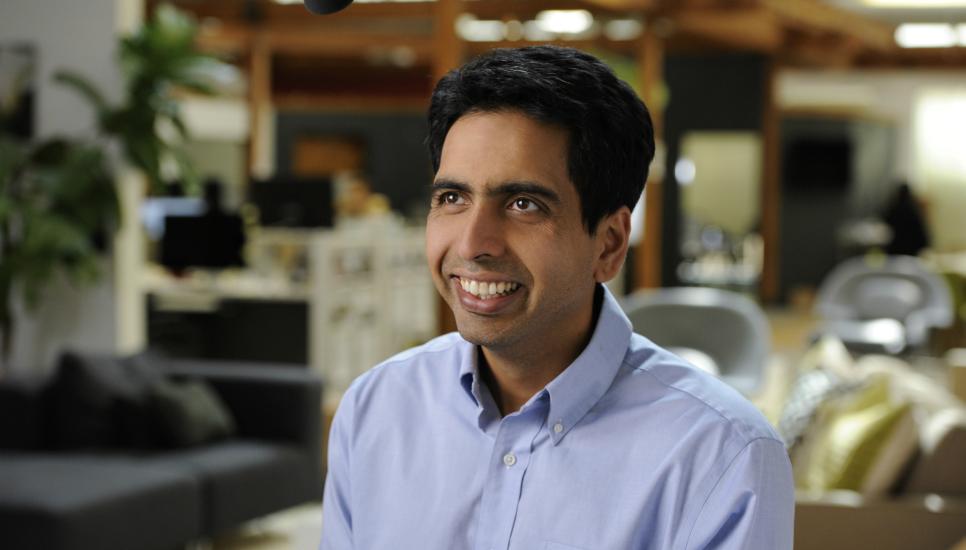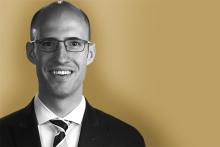Sal Khan: An educational entrepreneur

With 15 million registered students, 12 million average monthly visitors to its website, 900,000 registered teachers and over 3 billion exercises completed, Khan Academy is a nonprofit organisation on a mission to provide a free, world-class education for anyone, anywhere. As the founder and executive director of Khan Academy, Sal Khan has a legitimate claim to being a true modern revolutionary of education. CampdenFB spoke to Sal after his keynote address at IPI's 2015 Winter Forum in San Francisco.
Q: How and why did you start Khan Academy?
In 2004, having recently completed business school, I was working at a small hedge fund in Boston. During that time, I met up with some relatives from New Orleans. One of them was my 12-year-old cousin Nadia, who had taken a placement test and was subsequently being put into a slower math track in the seventh grade. I had trouble understanding why – she had always done well in math before – and I didn't think her parents, who hadn't gone to school in America, fully appreciated the implications of going into a slower math track. It follows you all the way through high school into college and can have implications for your career. So I offered to tutor her over the internet.
We started in August 2004, over the phone every day after work. Before this, she had effectively convinced herself that she wasn't capable of learning math. But slowly and surely, she filled the gaps in her knowledge. Then she really started racing ahead, and I became what I like to call a “tiger cousin” – I called up my cousin's school and told them that she should retake the placement test. They actually listened to me, and after acing her retest, she went from the slowest track to the most advanced track. I was a very proud cousin that day – and I was hooked on helping others learn.
Soon word got around the family that free tutoring was going on. So for the next few years, every day after work I found myself on conference calls with 15-20 cousins and family friends. I also built some software to give my cousins practice problems so that they could work on their math skills and get immediate feedback on their answers when I wasn't around.
Q: How did you go from tutoring a few cousins to an educational phenomenon?
Around November 2006, a friend asked me how I was planning to scale up my sessions with my cousins. He suggested I record some of the lessons as videos and upload them to YouTube. I immediately thought it was a horrible idea – YouTube is for cats playing piano, not for serious mathematics.
Eventually I got over the fact that it wasn't my idea and decided to give it a shot. I made about 10 very short videos on core topics and asked my cousins to watch them at their own pace, so that when we got on the phone we could dig deeper. After about a month of this, I asked my cousins for feedback. They told me that they liked me better on YouTube than in person! For me, the principal lesson was that when you are learning something new, the last thing you need is someone sitting there waiting for you to understand it. Too often, the fear of letting down the teacher leads the student to say, “yeah, I got it,” even if they haven't. But if the lessons are on-demand – like the videos – there's no judgment. You can work through them at your own time and pace, and you can repeat lessons as many times as you want.
I kept making more videos, which people outside my family began to find on YouTube. In 2008 I set up Khan Academy as a nonprofit, never really thinking I would leave my hedge fund job. But by fall 2009, Khan Academy was all I could think about. So I took a year off to see if I could turn it into a real organisation.
With all things entrepreneurial – whether for profit or nonprofit – in order to take that plunge, you have to start with an overly optimistic, almost delusional attitude. The mission I wrote on my IRS form was “a free, world-class education for anyone, anywhere.” I knew I wouldn't accomplish it immediately but thought it was a good goal to strive toward.
Q: When did you garner the attention of the likes of Bill Gates?
Initially, I relied on small gifts here and there to support Khan Academy. Then I was fortunate enough to be noticed by Ann Doerr, who provided our first larger-scale seed funding and is now our board chair.
Not long afterwards, Bill Gates spoke at the Aspen Ideas Festival. Asked an open-ended question about what he was most excited about in education, he referenced Khan Academy, saying he used it with his kids. Around the same time, people from Google reached out. I told both Google and the Gates Foundation that if I had more resources, I'd build out the exercise software and community and provide tools for parents and teachers.
By fall 2010, we had enough funding to staff a “real” organisation and start building out the software platform. To this day, we rely almost entirely on donations to cover the costs of running Khan Academy.
Q: How does your educational philosophy differ from the traditional model?
Once a student masters a foundational concept, they're ready to learn more advanced concepts that build off it. For instance, in math, once you master addition, you're ready for subtraction, then multiplication, then division, and so on – all the way up to calculus and statistics. It's just like in a video game, where you can't move to the next level until you've tackled the current one. This is common sense – but it isn't the way the traditional academic model works. Most education systems group students together – usually by age and perceived ability – and move them together at a set pace. Everyone takes the same exam at the same time, whether they're ready for it or not. Then students receive their scores. But even though the exam identifies gaps in student learning, the whole class moves on together to the next concept – which usually builds on the test content that students haven't fully mastered. Even a student who scored 95 per cent on the test is likely to have trouble – they're missing 5% of the knowledge they need to master the next concept. As these knowledge gaps accumulate, it becomes harder and harder for students to keep up with the material they're supposed to learn.
By predetermining when and how students learn something, the traditional model virtually guarantees that the variable will be how well students learn it. In this system, some students will always learn less than others. At Khan Academy, we believe that education should operate the other way around; the variable should be when and how students learn something, and what should be fixed is that every student masters the subject. It might take some students longer than others, but in the end, everyone should get a 100 per cent.
Q: Why did you develop the company as a nonprofit, rather than a for-profit?
I don't think we'd be the same organisation if we were for-profit. We'd still have a chance of being successful, but in a different way. We'd have nowhere near the goodwill or the reach that we have as a nonprofit.
Being a nonprofit means that we can't be bought and we can't be “IPO'ed.” We're also free to decide what content to create based on what learners need rather than what will drive revenue. Our bottom line isn't profit; it's a free, world-class education for anyone, anywhere.
One of the big practical challenges of being nonprofit is competing with other Silicon Valley firms for talent. Though we can't offer stock options, thanks to our donors, we can pay competitive salaries. And because we're mission-driven, we've been able to attract some of the best talent in the market, who want to be a part of what we're doing.
Q: What were your thoughts behind the Better Money Habits partnership with Bank of America?
In 2012, Bank of America approached us with an idea to help educate everyone about personal finance. We were already committed to doing that ourselves and were skeptical about working with a big bank; we didn't want to commercialise our efforts and we wondered what a commercial partner would do if, for instance, we created videos on how to avoid bank fees. Bank of America assured us that the whole reason they wanted to work with Khan Academy was our intellectual independence. They've been genuine in their interest, and the result is the portal BetterMoneyHabits.com, which aims to educate everyone about money matters.
Q: Why is a financial education important?
Put simply, how people manage their own finances can make a big difference in their lives. When I was still a hedge fund analyst, I remember being struck that when it came to investing and finance, my family and friends – knowledgeable in every other aspect of their lives – lived by rules of thumb rather than any deep understanding. I think Khan Academy can help change that. Through the resources we've created at BetterMoneyHabits.com, we can help people all over the world better understand personal finance and how it impacts them.
Q: What advice can you give families or individuals that are looking to make an impact in education beyond simply donating to a cause?
To start, choose a cause that you can become an ambassador for. Our donors have not only been incredibly generous in their financial support, but they've also played a vital role in connecting Khan Academy with other like-minded people who want to be part of the work we're doing.
When deciding where to donate, I think it's also important to consider the social return on investment. Many donors have told us that they're excited about supporting our work because Khan Academy is unique in its ability to scale and to reach learners and families around the globe directly. We have a relatively modest budget – similar to that of a large high school – but we reach 12 million learners every month.
Whether it's a large grant or a small gift, every donation matters. We're grateful for every contribution, and every dollar helps us provide two hours of free education. However if you quantify the impact, the social ROI is astronomical. And since education is critical to solving all kinds of problems around the world, a donation to education is inherently an investment in the future.
Q: What advice would you give budding entrepreneurs wanting to turn their ideas into reality?
Find a place where you can have a direct impact, and as you start to see that impact, think deeply about how you can scale it. In my case, I created Khan Academy to help me tutor my cousin Nadia. Once I found tools that worked, I began to think about how I could refine them to reach more and more students.
I'd also advise budding entrepreneurs to think on a multi-generational timeline, which can encourage more ambitious goals. For example, our mission at Khan Academy is a free, world-class education for anyone, anywhere. We won't achieve that tomorrow or even next year, but it inspires us to keep striving forward. And with the support of families around the world, I believe we can play an important part in realising this goal.






